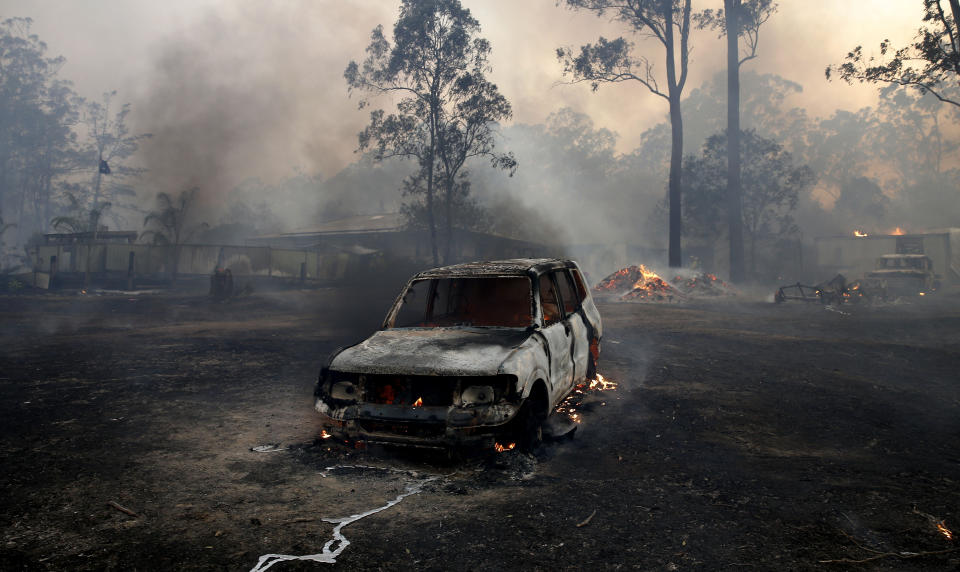'It's not normal': What's caused the bushfires and how can we stop them?
Catastrophic bushfires raging across NSW and Queensland could just be a grim sign of things to come over the next decade, an expert warns.
More than 55 fires continued to burn around NSW on Thursday morning, with 24 uncontained and eight currently at 'watch and act' level.
Four people have now been confirmed dead in the bushfires ravaging parts of NSW since last week.
More than 70 fires are now burning across Queensland since the current crisis erupted a week ago.
Dr Petr Matous, senior lecturer at Sydney University’s school of civil engineering, told Yahoo News Australia the current fires were a result of climate change, with blazes directly linked to a lack of rainfall due to the drought.
“There hasn’t been enough rain for too long and so all the fuel load is just too dry,” he said.
“Moisture levels in the forest in NSW are too low and the lack of rain is likely to do with climate change and is consistent with predictions of climate change.”

Dr Matous said southern and eastern parts of Australia would likely suffer through droughts over the next 10 years, which he believes is a heightened threat due to climate change.
“It is devastating to think that the current disasters may be just a trailer of what might be coming in the next decades,” he said.
“Some seasons will be wetter and safer than others depending on oscillating climatic systems such as El Niño, and in some areas, severe droughts might limit future vegetation growth which would decrease the amount of fuel for bushfires.
“The overall trend, however, is likely to be towards more hazards.”
‘There’s something going on’
The former head of Queensland's fire service has also pointed to climate change as the driver behind dry conditions that are fanning dozens of bushfires across the state.
Lee Johnson, former Queensland Fire and Emergency Services Commissioner, on Friday said the bushfire season that has razed homes and hundreds of thousands of hectares of land was like nothing he'd seen in his decades-long career.
"I'm here for my children and my grandchildren, because I am fundamentally concerned about the impact and the damage coming from climate change," he said.
"There's something going on, and climate change is exacerbating the dry conditions we are all experiencing."

Mr Johnson warned conditions would remain extreme through the summer without significant rain.
There is no rain forecast until early next year.
Vegans outraged over Bunnings sausage sizzle benefiting firefighters
Domestic violence activist slammed for 'idiotic' comments about firefighters
Instagram influencer slammed for 'insensitive' bushfires fundraiser
"In Queensland alone, without speaking for the rest of the country, we need hundreds of millimetres of rain to bring the risk back to something like normal," Mr Johnson added.
"So our conditions are very much abnormal and driven very much by what's happening in our atmosphere, and that influenced by greenhouse gases."
‘Australians deserve the truth’
The Morrison government continues to insist it is not the time to talk climate policy while the nation burns, but scientists and environmentalists say there is no better time.
The Climate Council has published a briefing paper saying catastrophic fire conditions across NSW and Queensland this week have been aggravated by climate change.
“The situation is not normal,” it says bluntly.
"To not talk about climate change is like not talking about speeding after a car crash," council chief executive Amanda McKenzie told AAP on Wednesday.
"Australians deserve the truth about bushfires and climate change. The truth is lighting up right in front of us."

In a separate briefing, fire experts said the scale of the disaster was now in "uncharted territory".
There were likely to be long-term environmental consequences from the fires, University of Wollongong Centre for Environmental Risk Management of Bushfires head Ross Bradstock said.
"The background dryness created by the drought makes fuel available to burn and once the fire is going, the hot, dry, windy weather and low humidities promote the rapid spread of a fire," he told reporters.
"The full significance of these fires will take a long time to examine and unravel."
How can the bushfire disaster be prevented?
While the Greens were blamed earlier this week for causing the bushfires because of the party’s opposition of hazard reduction burns, Dr Matous said backburning had not been limited in the lead up to bushfire season this year.
However, the issue is the bushfire season came early, meaning backburning could come with its own set of problems as it could cause the beginning of a ferocious fire.
“It can defeat the purpose by just creating another dire fire that can get out of control,” Dr Matous said.
He suggested it was time to think about other methods rather than relying on backburning.

“We will probably have to change the interface between the bushland and people’s homes,” he said.
“There’s a limitation on how much you can reduce the risk with traditional methods and you can’t completely eliminate the hazards with backburning.”
Dr Matous said there should be a 50-metre wide clearing between homes and bushland, whether that is a belt of green space or a man-made body of water.
“It makes a big difference and the hazards will decrease significantly,” he said.
“These climatic changes, accompanied by demographic changes driving increasing numbers of Sydneysiders towards tree-change, will require a new approach to spatial and infrastructure planning in most hazard-prone areas to provide more robust buffer zones between the bush and people’s homes."
With AAP
Do you have a story tip? Email: newsroomau@yahoonews.com.
You can also follow us on Facebook and Twitter, download the Yahoo News app from the App Store or Google Play and stay up to date with the latest news with Yahoo’s daily newsletter. Sign up here.



